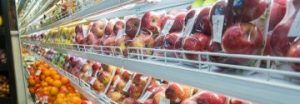
R2101 February 2016 – Plant Growth Propagation and Development
Q.3. Aerobic Respiration and Crop Storage
Question:
Q.3. a) State the products of aerobic respiration
b) Name TWO factors which affect the rate of respiration.
c) Describe the importance of aerobic respiration when storing fruit and vegetables.
Question: copyright – RHS
Sample Answers:
Q.3.a. The products of aerobic respiration are carbon dioxide, water and energy (in the form of heat and ATP).
You could also have shown the equation for aerobic respiration instead, as long as it showed all of the products mentioned above, for example:

Or you could show the chemical formula:

b. The two main environmental factors affecting rate of respiration in plants are temperature and oxygen level:
- Amount of oxygen in the atmosphere. Very low levels of oxygen will slow the process of respiration or trigger anaerobic respiration.
- Temperature of the surrounding air. Respiration rate is slower at lower temperatures and increases as the temperature increases. However, if temperatures are too high, this will also cause respiration to stop.
However, the examiners also accepted:
- ‘Type of tissue, organ or stage of growth.’ For example, younger growing tissues (such as meristems) which have a greater amount of protoplasm as compare to older tissues, show a higher rate of respiration. Their higher rate of respiration is required to provide the extra energy needed when young cells are actively dividing and/or growing.
(We’ve expanded on each of these points a little more in the Background Information below.)
c. Respiration uses sugars made during photosynthesis to release the energy required by the plant. Once a fruit or vegetable has been harvested, respiration continues. However the plant sugars used in respiration are not being replaced and the harvested crop will eventually begin to senesce, with tissues breaking down and decomposing (rotting).
By controlling the environmental conditions that affect the rate of respiration, we can decrease the rate of respiration, and thus also slow the rate of senescence. This can extend the storage life of fruit and vegetables significantly and ensure they reach market in good condition.
Methods of slowing respiration rate include:
- reducing temperature (e.g. in refrigerated storage),
- reducing oxygen levels, for example, by placing fruit or veg in a controlled atmosphere store or in a sealed plastic package (once the oxygen available in the package is used up, oxygen levels will be very low).
- changing the composition of the gaseous environment by increasing carbon dioxide or adding other gases (e.g. higher levels of nitrogen reduce respiration and extend storage life).
*Background (not to be included in answer) – combinations of gases need to be carefully controlled. If the oxygen supply is too low, it may cause anaerobic respiration, which will have a detrimental affect on the stored fruit or vegetables. For example, the optimal conditions for storing mature tomatoes have been found to be 3 – 5% oxygen, 1 – 5% carbon dioxide, and 94 – 96% nitrogen gas.
I K Arah, et al, (2015) Preharvest and Postharvest Factors Affecting the Quality and Shelf Life of Harvested Tomatoes: A Mini Review
Background Information:
3. b. Below we’ve expanded on the factors listed in 3b. This information is not required in the exam answer but may aid understanding:
- Amount of oxygen in the atmosphere.In a low oxygen environment (as could occur, for example, in a greenhouse at night where all the plants are respiring) the rate of respiration is usually reduced. However, no significant drop in respiration rate occurs until the percentage of oxygen in the air drops to below 10% (The average oxygen content of air is 20.95%. This declines slightly with altitude. A 0.7% decline in the atmospheric pressure of oxygen occurs at about 100 metres, meaning that at altitude oxygen is less available.)In the absence of oxygen, plants suffer tissue anoxia and begin to respire anaerobically. This might occur if, for example, the soil around plant roots is temporarily waterlogged. The root cells begin to respire anaerobically as they have no access to oxygen. However, in most cases, this is only a temporary measure as the main product of anaerobic respiration (ethanol in most plants) is toxic to plant tissues when present for long periods or at high levels. If aerobic respiration is not able to restart fairly quickly, cell death and tissue decay (rotting) may occur.
When storing crops such as fruit and vegetables, low oxygen levels may be used to slow respiration rate and thus also slow the process of senescence (plant ageing and death).
The word equation for anaerobic respiration is:

Some plants cope well with anaerobic conditions, for example, when oxygen is no longer available to rice seedlings, the rate of respiration actually increases. Prolonged tissue anoxia (lack of oxygen) is also tolerated by many rhizomes and tubers, and some shoots of wetland species.
- Temperature of the surrounding air. The respiration rate is slower at lower temperatures and increases as the temperature increases. However, if temperatures are too high, this will also cause respiration to stop, as the enzymes that control respiration are damaged by high temperature. This means that temperature is of key importance when storing fruit, vegetables and other crops. Refrigeration is often used to slow respiration during storage. Typical temperatures are around 5oC. Some crops can be frozen, but many cannot, as freezing damages delicate tissues; for instance, most beans can be frozen shortly after harvest without causing obvious tissue damage, but if soft fruit such as strawberries are frozen significant tissue damage occurs.
- The examiners also accepted: ‘Type of tissue, organ or stage of growth.’For example, younger growing tissues (such as meristems) which have a greater amount of protoplasm in comparison to older tissues, show higher rates of respiration. This higher rate of respiration is required to provide the extra energy needed when young cells are actively dividing and/or growing.In contrast, most seeds, which are very dry, have such a low moisture content that respiration is not possible. When the moisture content increases, the rate of respiration usually also increases (unless it is inhibited in some other way) resulting in a rapid loss of viability and spoilage of the stored seed. What this means for storage is that moisture levels also need to be kept quite low for most crops.
Plant parts that were actively growing when harvested are likely to senesce (age/deteriorate) more quickly because they respire more quickly. Carefully controlled storage conditions, such as low oxygen, low temperature and low moisture help to prevent this.
Top image: Latte Art / Shutterstock.com

